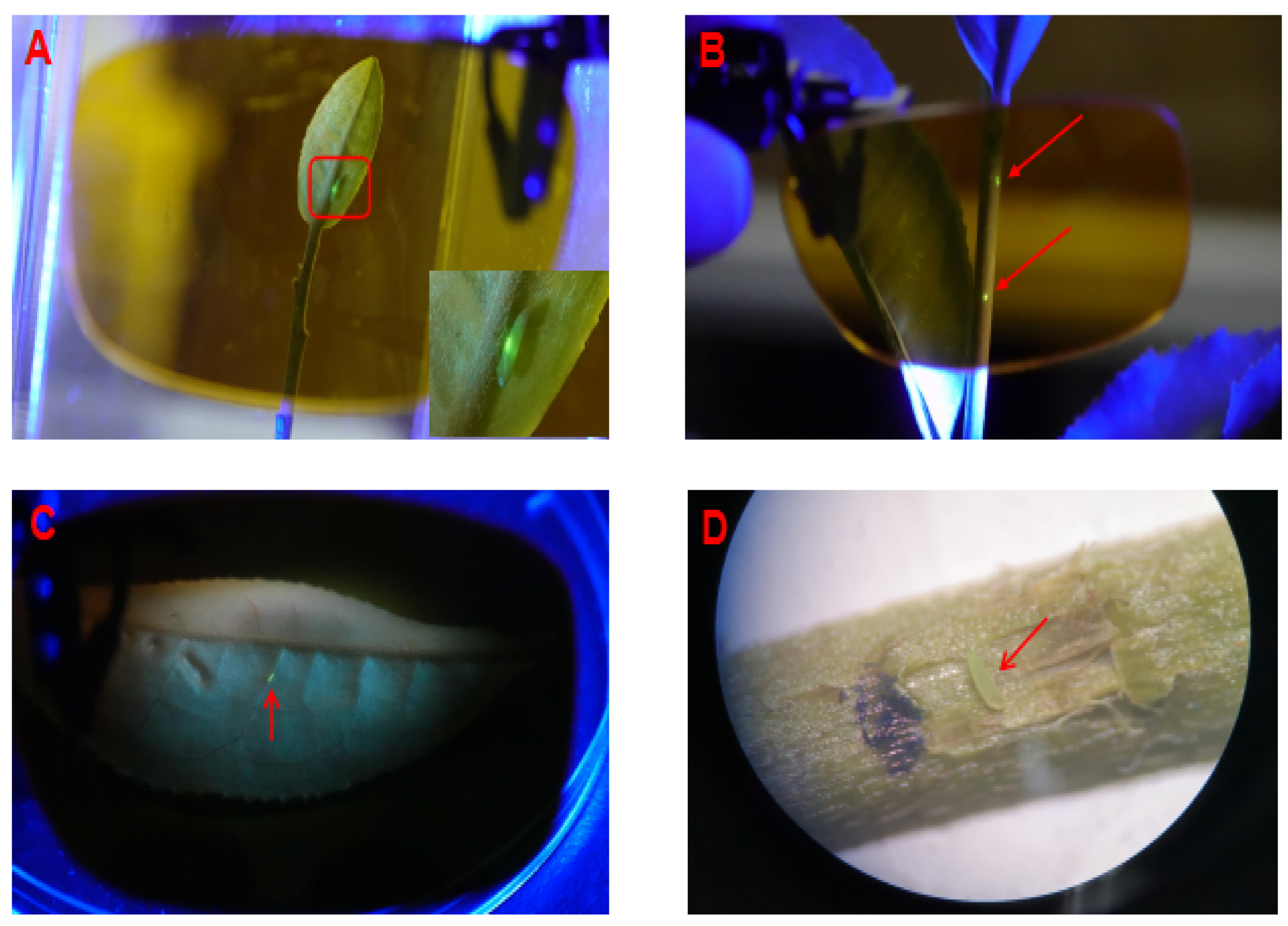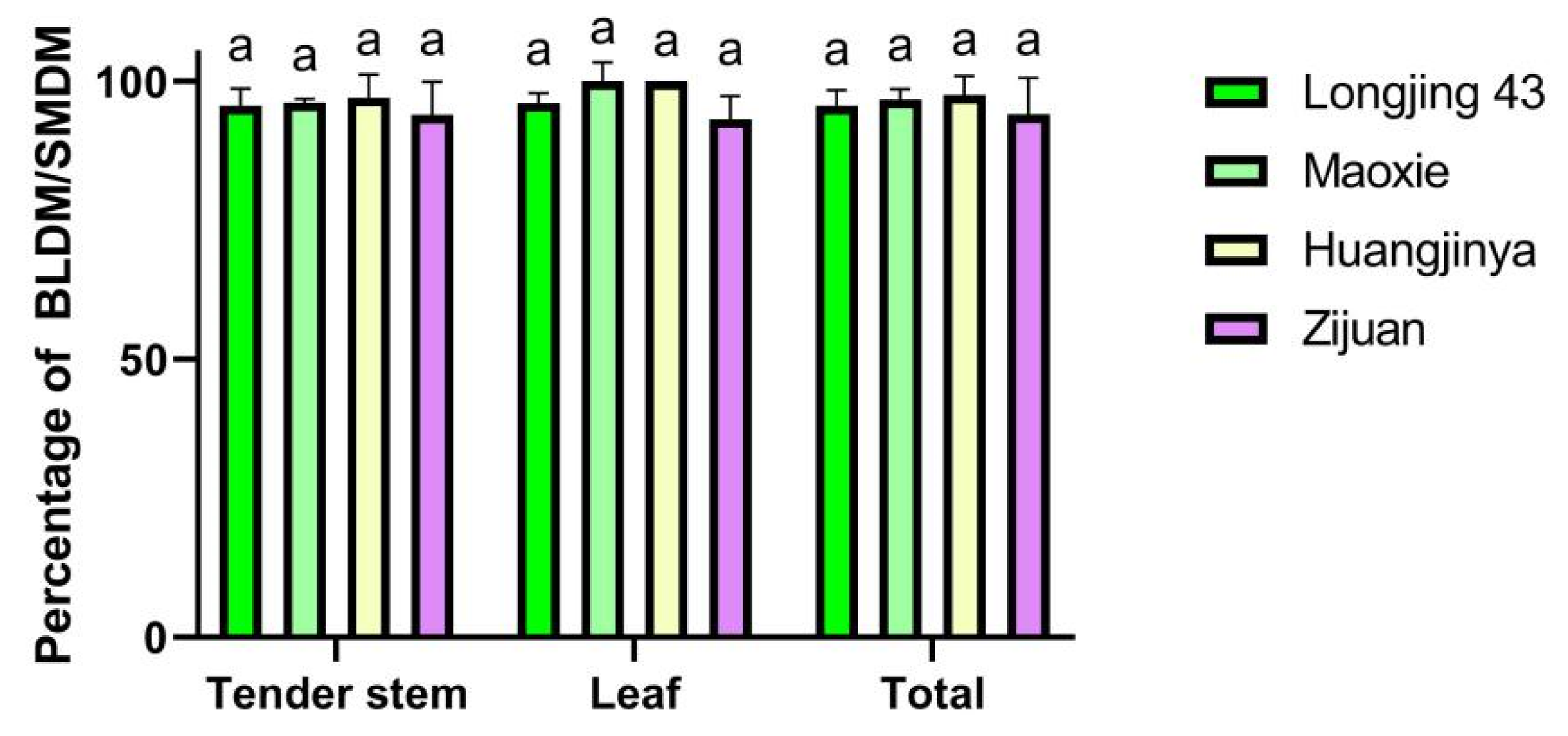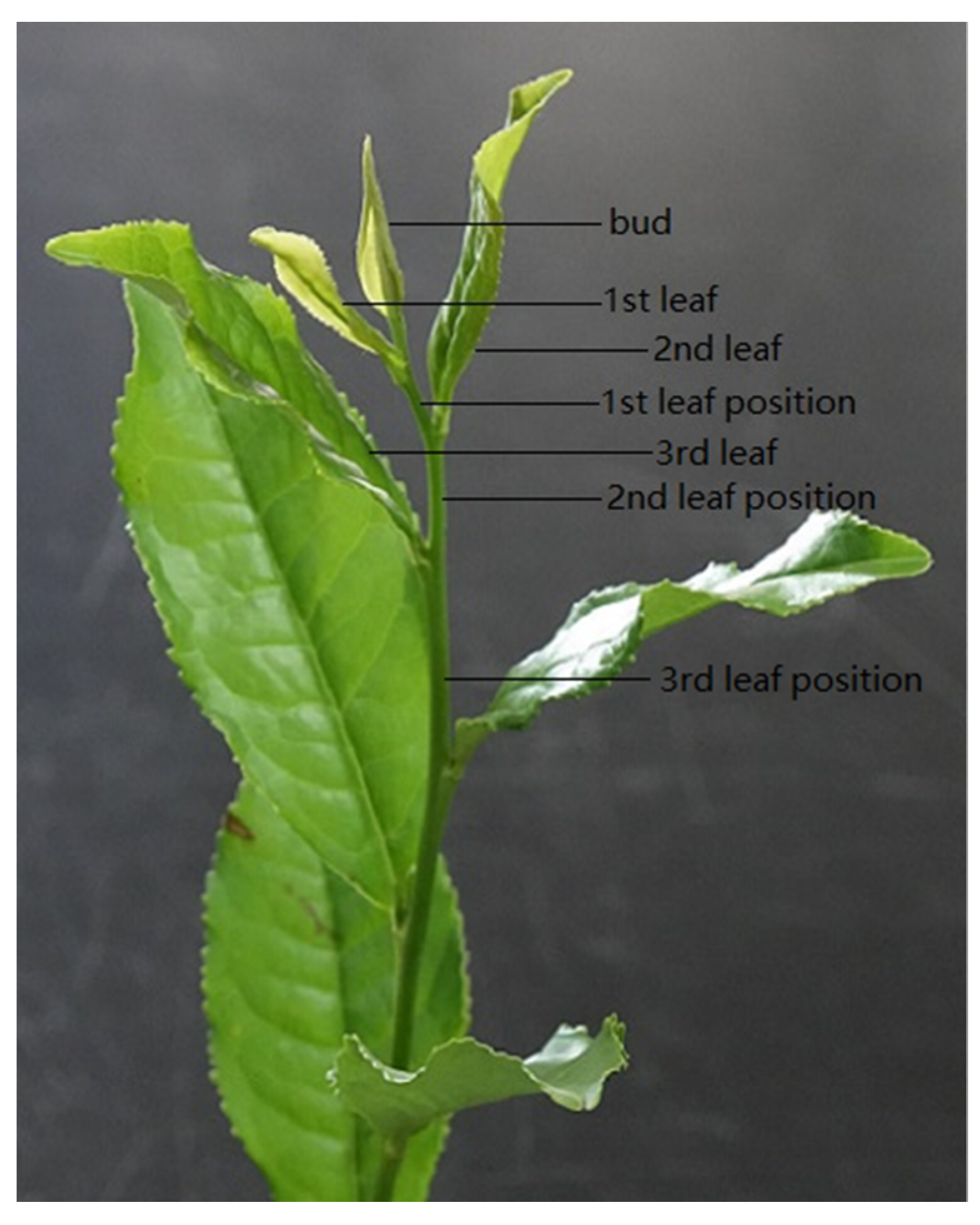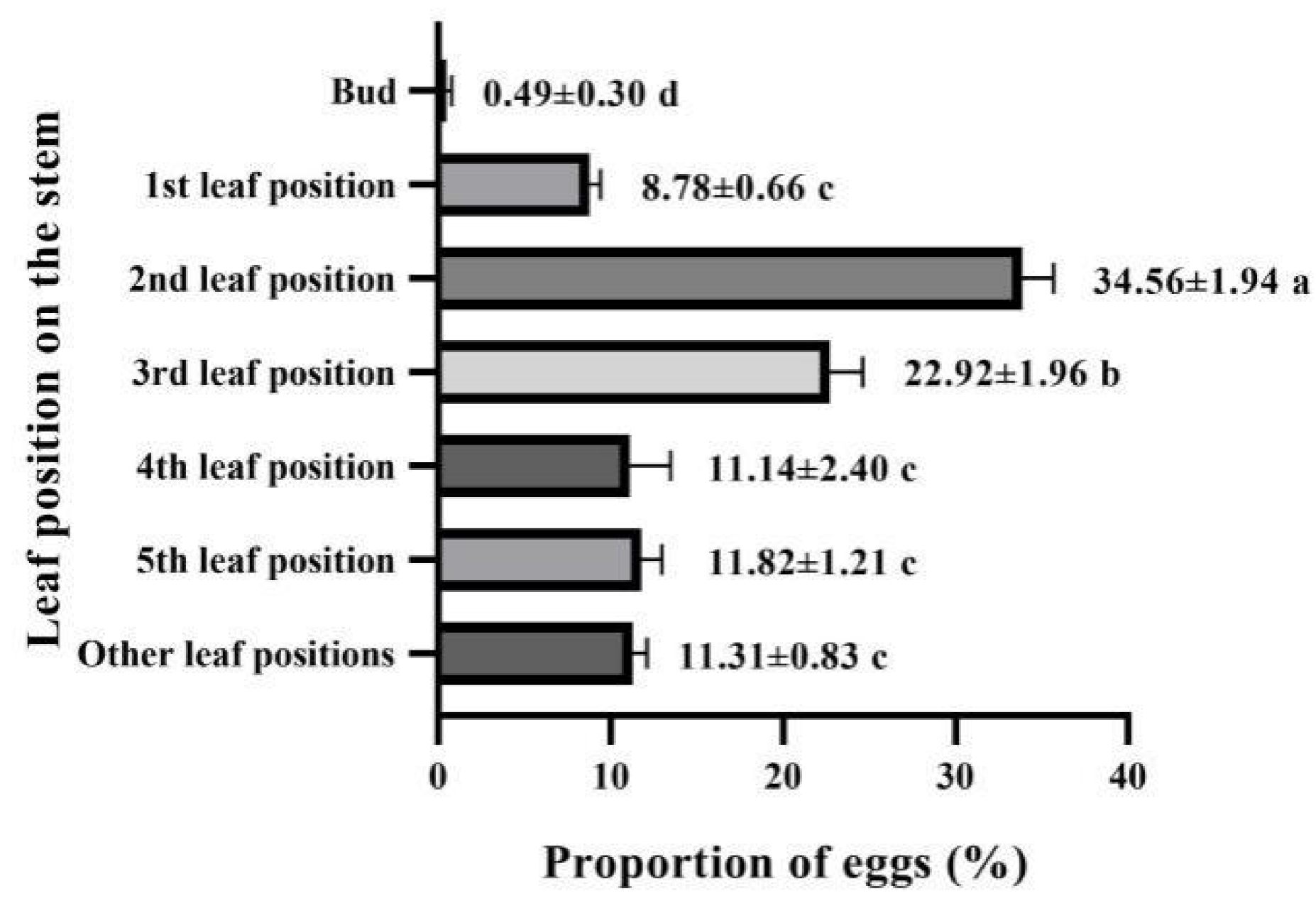Identifying the Biological Characteristics Associated with Oviposition Behavior of Tea Leafhopper Empoasca onukii Matsuda Using the Blue Light Detection Method
Simple Summary
Abstract
1. Introduction
2. Materials and Methods
2.1. Insects and Tea Shoots
2.2. The Accuracy of Blue Light Detection Method (BLDM) for Locating Eggs of E. onukii within Intact Tea Shoots
2.2.1. Observation and Location of E. onukii Eggs by BLDM Inside Intact Tea Shoots
2.2.2. Accuracy Examination of BLDM for Investigating Eggs of E. onukii
2.2.3. Comparison of BLDM and SMDM in the Detection of E. onukii Eggs on High-Egg-Density Tea Shoot
2.3. Biological Characteristics Associated with the Oviposition Behavior of E. onukii
2.3.1. Zygote State
2.3.2. Ovipositional Rhythm and Egg Distribution
2.3.3. Number of Eggs Laid Daily by a Single Female
2.3.4. Total Eggs Laid by a Single Female
2.4. Data Analysis
3. Results
3.1. Video Observation of Egg Laying Behavior of E. onukii
3.2. Observation and Clarification of E. onukii Egg by Blue Light Detection Method (BLDM)
3.3. Inspection Accuracy of BLDM for E. onukii Eggs
3.4. Comparison between BLDM and SMDM in Detecting E. onukii Eggs
3.5. Fertilized Ovum State of E. onukii
3.6. Ovipositional Rhythm and Egg Distribution by E. onukii
3.7. Egg Laying by Single Females Daily and the Whole Generation
4. Discussion
5. Conclusions
Author Contributions
Funding
Acknowledgments
Conflicts of Interest
References
- Tang, Y.C.; Zhou, C.L.; Chen, X.M. Progress in the oviposition behavioral ecology of herbivorous insects. For. Res. 2010, 23, 770–777. [Google Scholar]
- Cai, W.Z.; Pang, X.F.; Hua, B.Z.; Liang, G.W.; Song, D.L. General Entomology, 2nd ed.; China Agricultural University Press: Beijing, China, 2011; p. 210. [Google Scholar]
- Cao, X.Y.; Wang, Y.C.; Gong, X.J.; Xu, Z.X.; Luo, F. Regional occurrence characteristics of E. (Matsumurasca) onukii Matsuda and its integrated controlling. China Plant Prot. 2018, 38, 25–32. [Google Scholar]
- Qin, D.Z.; Zhang, L.; Xiao, Q.; Dietrich, C.; Matsumura, M. Clarification of the identity of the tea green leafhopper based on morphological comparison between Chinese and Japanese specimens. PLoS ONE 2015, 10, e0139202. [Google Scholar] [CrossRef] [PubMed]
- Backus, E.A.; Serrano, M.S.; Ranger, C.M. Mechanisms of hopperburn: An overview of insect taxonomy, behavior, and physiology. Annu. Rev. Entomol. 2005, 50, 125–151. [Google Scholar] [CrossRef]
- Wei, Q.; Gao, C.F. Advance in research occurrence regularity and controlling of the tea green leafhopper, E. vitis (Gӧthe). Tea Sci. Technol. 2014, 1, 7–11. [Google Scholar]
- Kosugi, Y. Overwintering ecology of tea green leafhopper, E. onukii Matsuda in tea field. (2) First oviposition time of the overwintered female. Proc. Kansai PI. Prot. 1996, 38, 49–50. [Google Scholar]
- Kosugi, Y. Oviposition sites of tea green leafhopper, E. onukii Matsuda in a new shoot of tea plants. Proc. Kansai PI. Prot. 1998, 40, 153–154. [Google Scholar]
- Wang, Y.J.; Xie, Z.L.; Pang, X.F. Studies on the ecological niche of E. vitis (Göthe) and spiders in tea gardens. J. Tea Sci. 2008, 28, 401–406. [Google Scholar]
- Wang, Q.S.; Huang, J.; Gao, X.F. Studies on the spatial distribution of E. vitis (Gӧthe) in organic tea garden. Chin. Agric. Sci. Bull. 2010, 26, 234–237. [Google Scholar]
- Chen, L.L.; Chen, P.; Wang, Y.; Ma, X.; Lin, J.K.; Zhao, Z.H. Cover crops mediate abundance and egg density of tea green leafhopper (Hemiptera: Cicadellidae) in a tea plantation. J. Plant Prot. 2019, 46, 989–996. [Google Scholar]
- Li, H.L.; Lin, N.Q. The influence of temperature and humidity on the population dynamics of small green leafhopper at tea garden. Fujian J. Agric. Sci. 2012, 27, 55–59. [Google Scholar]
- Li, H.L.; Liu, F.J.; Wang, D.F.; Zhang, W.J.; Wu, G.Y.; Lin, N.Q. Effects of shading on population dynamics of small green leafhopper. Fujian J. Agric. Sci. 2013, 28, 1281–1284. [Google Scholar]
- Qiao, L. Response of E. onukii Matsuda to Short-Term High or Low Temperature and the Molecular Mechanisms. Ph.D. Thesis, Northwest A&F University, Yangling, China, 2015. [Google Scholar]
- Gao, M.Q. Studies on the Small Green Leafhopper, E. vitis (Göthe) and its Egg Parasitoids in Fujian Tea Plantations. Master’s Dissertation, Fujian Agriculture and Forestry University, Fuzhou, China, 2007. [Google Scholar]
- Li, H.L. Studies on the Bionomics of Small Green Leafhopper and its Egg Parasitoids. Master Dissertation, Fujian Agriculture and Forestry University, Fuzhou, China, 2008. [Google Scholar]
- Xu, L.Y. Effects of Intercropping Tea Plantation with Green Manure on the Green Leafhopper and Main Natural Enemies of Pests. Master’s Dissertation, Fujian Agriculture and Forestry University, Fuzhou, China, 2013. [Google Scholar]
- Mao, Y.X.; Zou, W.; Ma, X.H.; Lin, N.Q. Fuzzy cluster analysis of the dynamics of egg density and egg parasitism of E. vitis (Göthe). J. Fujian Agric. Forest. Univ. 2009, 38, 16–18. [Google Scholar]
- Lin, J.L. Studies on Chemical and Color Communication Mechanisms among Tea and Tea Green Leafhopper and Mymarid. Master’s Dissertation, Yangzhou University, Yangzhou, China, 2010. [Google Scholar]
- Jin, S. Resistance Mechanisms of Tea Plant Cultivars to Tea Green Leafhopper. Ph.D. Thesis, Northwest A&F University, Yangling, China, 2012. [Google Scholar]
- Boll, S.; Herrmann, J.V. A new method to monitor eggs of the grape leafhopper (E. vitis) in grapevine leaves. J. Plant Dis. Prot. 2001, 108, 77–81. [Google Scholar]
- Herrmann, J.V.; Boll, S. A simplified method for monitoring eggs of the grape leafhopper (E. vitis) in grapevine leaves. J. Plant Dis. Prot. 2004, 111, 193–196. [Google Scholar] [CrossRef]
- Kosugi, Y. Effect of temperatures on development period of tea green leafhopper, E. onukii Matsuda. Proc. Kansai PI. Prot. 1994, 36, 35–36. [Google Scholar]
- Goodey, T. Two methods for staining nematodes in plant tissues. J. Helminthol. 1937, 15, 137–144. [Google Scholar] [CrossRef]
- Carlson, O.V.; Hibbs, E.T. Direct counts of potato leafhopper, E. fabae, eggs in solanum leaves. Ann. Entomol. Soc. Am. 1962, 55, 512–515. [Google Scholar] [CrossRef]
- Backus, E.A.; Hunter, W.B.; Arne, C.N. Technique for staining leafhopper (Homoptera: Cicadellidae) salivary sheaths and eggs within unsectioned plant tissue. J. Econ. Entomol. 1988, 81, 1819–1823. [Google Scholar] [CrossRef]
- Moffitt, H.R.; Reynolds, H.T. Bionomics of E. solana DeLong on cotton in Southern California. Hilgardia 1972, 41, 247–297. [Google Scholar] [CrossRef]
- Singh, L.; Singh, R. Influence of leaf vein morphology in OkraGenotypes (Malvaceae) on the oviposition of the leafhopper species Amrasca biguttula (Hemiptera: Cicadellidae). Entomol. Gen. 2005, 28, 103–114. [Google Scholar] [CrossRef]
- Khan, Z.R.; Saxena, R.C. Technique for locating planthopper (Homoptera: Delphacidae) and leafhopper (Homoptera: Cicadellidae) eggs in rice plants. J. Econ. Entomol. 1986, 79, 271–273. [Google Scholar] [CrossRef]
- Chen, Z.M. Chemical Ecology of Tea Pests; Shanghai Scientific & Technical Publishers: Shanghai, China, 2013; pp. 1–14. [Google Scholar]




| Cultivar | Tree Age | Tender Stem | Leafhopper Resistance | |
|---|---|---|---|---|
| Thickness | Epidermis Color | |||
| Longjing 43 | 5 | Medium | Green | Medium |
| Maoxie | 5 | High | Green | Medium |
| Huangjinya | 5 | Medium | Golden yellow | Medium |
| Zijuan | 5 | High | Purple | High |
| Cultivar | No. of Shoots | No. of Eggs | 7 d | |
|---|---|---|---|---|
| No. of Hatched Nymphs | No. of Eggs | |||
| Longjing 43 | 10 | 0 | 0 | 0 |
| 10 | 40 | 35 | 3 | |
| Maoxie | 10 | 0 | 0 | 0 |
| 10 | 36 | 32 | 4 | |
| Huangjinya | 10 | 0 | 0 | 0 |
| 10 | 33 | 31 | 1 | |
| Zijuan | 10 | 0 | 0 | 0 |
| 10 | 28 | 26 | 0 | |
| Cultivar | Detection Method | Eggs/Ten Tea Shoots | ||||||||
|---|---|---|---|---|---|---|---|---|---|---|
| Bud | First Leaf Position | Second Leaf Position | Third Leaf Position | Fourth Leaf Position | Other Leaf Positions | Total on Tender Stem | Total on Leaf | Total Sum | ||
| Longjing 43 | A: BLDM B: SMDM A/B (%) | 2 | 5 | 20.33 | 55 | 36 | 41 | 157.33 | 24 | 181.33 |
| 4 | 7.33 | 23.67 | 57.33 | 35.33 | 41 | 164.67 | 25 | 189.67 | ||
| 50 | 68.18 | 85.92 | 95.93 | 101.89 | 100 | 95.55 | 96 | 95.61 | ||
| Maoxie | A: BLDM B: SMDM A/B (%) | 0.33 | 2 | 15.67 | 46.67 | 21 | 22 | 107.33 | 16 | 123.33 |
| 0.67 | 4.67 | 16.33 | 47 | 21.67 | 22 | 111.67 | 16 | 127.67 | ||
| 50 | 42.86 | 95.92 | 99.29 | 96.92 | 100 | 96.12 | 100 | 96.61 | ||
| Huangjinya | A: BLDM B: SMDM A/B (%) | 0.67 | 2.33 | 13 | 48.33 | 19.33 | 12 | 95 | 16.33 | 111.33 |
| 1 | 4.33 | 13.67 | 48.33 | 19.67 | 12 | 98 | 16.33 | 114.33 | ||
| 66.67 | 53.85 | 95.12 | 100 | 98.31 | 100 | 96.94 | 100 | 97.38 | ||
| Zijuan | A: BLDM B: SMDM A/B (%) | 1 | 1 | 17.33 | 24 | 12.67 | 17.33 | 72.33 | 13.67 | 86 |
| 1.67 | 3 | 19.33 | 25 | 12.67 | 17.33 | 77.33 | 14.67 | 92 | ||
| 60 | 33.33 | 89.66 | 96 | 100 | 100 | 93.53 | 93.18 | 93.48 | ||
| Replicate | Mating Time | First Survey (Egg in the Abdomen) | Second Survey (Egg in the Tea Shoots) | Third Survey (Egg in the Tea Shoots) | |||||||
|---|---|---|---|---|---|---|---|---|---|---|---|
| Date (Month/Day) | Time (h/min) | Date (Month/Day) | Time (h/min) | Zygote State (h/mins) | Date (Month/Day) | Time (h/min) | Egg | Date (Month/Day) | Time (h/min) | Egg | |
| 1 | 10.11 | 21:59 | 10.13 | 8:30 | 34: 31 | 10.14 | 8:30 | 2 | 10.15 | 13:30 | 4 |
| 2 | 10.12 | 8:35 | 10.13 | 13:30 | 28: 55 | 10.14 | 13:30 | 3 | 10.16 | 13:30 | 7 |
| 3 | 10.24 | 18:10 | 10.25 | 20:00 | 25: 50 | 10.26 | 8:30 | 1 | 10.28 | 8:30 | 4 |
| 4 | 11.12 | 20:27 | 11.14 | 8:30 | 36: 03 | 11.15 | 8:30 | 2 | 11.16 | 13:30 | 3 |
| 5 | 11.19 | 12:18 | 11.20 | 20:00 | 31: 42 | 11.21 | 8:30 | 1 | 11.22 | 13:30 | 3 |
| Period | Egg | Proportion of Egg (%, Mean ± SE) | ||
|---|---|---|---|---|
| Tender Stem | Leaf | Total (Mean ± SE) | ||
| 2:30–5:30 | 11.75 | 1.75 | 13.50 ± 3.86 bc | 9.81 ± 2.40 |
| 5:30–8:30 | 9.25 | 1 | 10.25 ± 1.93 c | 7.50 ± 1.12 |
| 8:30–11:30 | 11.75 | 1.5 | 13.25 ± 3.50 bc | 9.43 ± 2.08 |
| 11:30–14:30 | 12.25 | 2 | 14.25 ± 1.25 bc | 10.73 ± 0.77 |
| 14:30–17:30 | 15.25 | 2.75 | 18.00 ± 2.94 bc | 13.76 ± 2.53 |
| 17:30–20:30 | 17.75 | 4.5 | 22.25 ± 3.61 ab | 17.90 ± 4.91 |
| 20:30–23:30 | 28 | 2 | 30.00 ± 4.78 a | 22.12 ± 2.02 |
| 23:30–2:30 | 10.75 | 1.75 | 12.50 ± 3.57 bc | 9.27 ± 2.32 |
| Total | 117 | 17 | 134 | |
| Proportion (%) | 86.685 | 13.315 | - | |
| Date (Month/Day) | Eggs/Ten Females | |||
|---|---|---|---|---|
| Replicate 1 | Replicate 2 | Replicate 3 | Replicate 4 | |
| 8.1 | 14 | 6 | 17 | 6 |
| 8.2 | 30 | 16 | 10 | 13 |
| 8.3 | 42 | 22 | 16 | 27 |
| 8.4 | 34 | 53 | 35 | 29 |
| 8.5 | 18 | 20 | 20 | 26 |
| 8.6 | 45 | 66 | 40 | 47 |
| 8.7 | 34 | 50 | 49 | 28 |
| Total | 217 | 233 | 187 | 176 |
| Mean/Female per day | 3.10 | 3.33 | 2.67 | 2.51 |
| Date (Month/Day) | Eggs/Five Females | |||
|---|---|---|---|---|
| Replicate 1 | Replicate 2 | Replicate 3 | Replicate 4 | |
| 8.9 | 40 | 13 | 23 | 25 |
| 8.12 | 38 | 40 | 10 | 16 |
| 8.15 | 20 | 21 | 10 | 8 |
| 8.18 | 30 | 44 | 22 | 21 |
| 8.21 | 46 | 39 | 23 | 21 |
| 8.24 | 31 | 43 | 4 | 15 |
| 8.27 | 9 | 6 | 3 | 0 |
| 8.30 | 0 | 0 | 0 | 0 |
| Total | 214 | 206 | 95 | 106 |
| Mean/Female | 42.8 | 41.2 | 19 | 21.2 |
Publisher’s Note: MDPI stays neutral with regard to jurisdictional claims in published maps and institutional affiliations. |
© 2020 by the authors. Licensee MDPI, Basel, Switzerland. This article is an open access article distributed under the terms and conditions of the Creative Commons Attribution (CC BY) license (http://creativecommons.org/licenses/by/4.0/).
Share and Cite
Yao, Q.; Zhang, H.; Jiao, L.; Cai, X.; Wang, M.; Chen, Z. Identifying the Biological Characteristics Associated with Oviposition Behavior of Tea Leafhopper Empoasca onukii Matsuda Using the Blue Light Detection Method. Insects 2020, 11, 707. https://doi.org/10.3390/insects11100707
Yao Q, Zhang H, Jiao L, Cai X, Wang M, Chen Z. Identifying the Biological Characteristics Associated with Oviposition Behavior of Tea Leafhopper Empoasca onukii Matsuda Using the Blue Light Detection Method. Insects. 2020; 11(10):707. https://doi.org/10.3390/insects11100707
Chicago/Turabian StyleYao, Qi, Huining Zhang, Long Jiao, Xiaoming Cai, Manqun Wang, and Zongmao Chen. 2020. "Identifying the Biological Characteristics Associated with Oviposition Behavior of Tea Leafhopper Empoasca onukii Matsuda Using the Blue Light Detection Method" Insects 11, no. 10: 707. https://doi.org/10.3390/insects11100707
APA StyleYao, Q., Zhang, H., Jiao, L., Cai, X., Wang, M., & Chen, Z. (2020). Identifying the Biological Characteristics Associated with Oviposition Behavior of Tea Leafhopper Empoasca onukii Matsuda Using the Blue Light Detection Method. Insects, 11(10), 707. https://doi.org/10.3390/insects11100707






